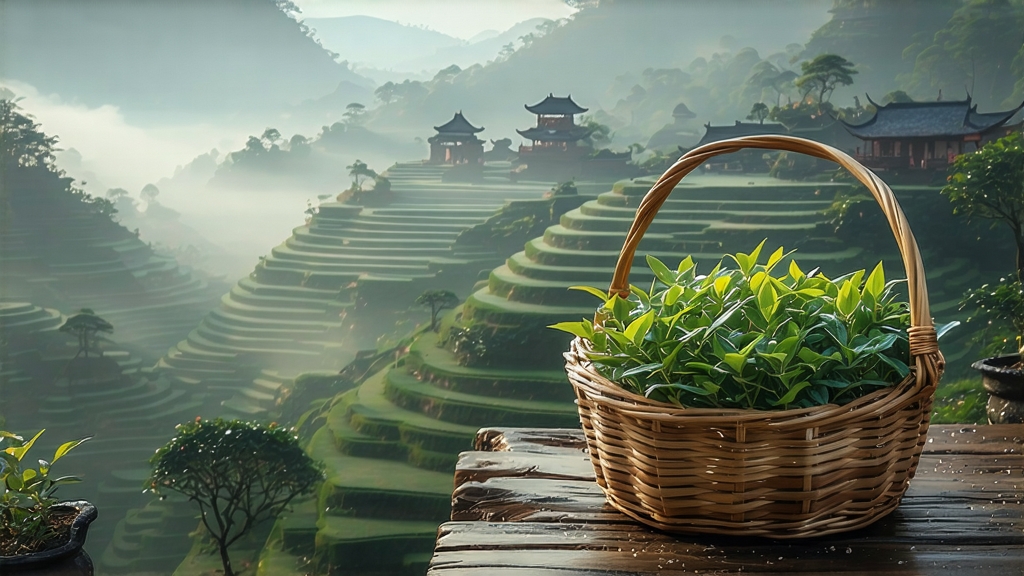
Tucked high on the northern rim of the Sichuan Basin, Meng Ding Mountain has been wrapped in cloud and legend for more than two millennia. It was here, in 53 BCE, that the Daoist hermit Wu Lizhen planted seven tea bushes that later became China’s first officially recorded garden. When Tang-dynasty emperors demanded “the first spring sprout under heaven,” those bushes supplied it; when Song court scholars compiled the “Cha Jing,” they listed Meng Ding Huang Ya—literally “Meng Ding Yellow Bud”—as one of only five tribute teas worthy of the Son of Heaven. Today the same mountain, now a UNESCO mixed heritage site, still produces the tiny golden buds that define the yellow-tea category for connoisseurs worldwide.
What makes Meng Ding Huang Ya a yellow tea rather than a green one is the almost-forgotten art of men huang—“sealed yellowing.” After picking, the leaf is never allowed to oxidise into black-tea territory, yet it is gently coaxed past the bright-green arrest of green tea. The result is a liquor the colour of topaz, a bouquet that hovers between orchid and steamed corn, and a sweetness that lingers like warm honey on the back palate.
Harvest
The picking window is cruelly short: only ten days between Qing Ming and the spring rain, when the bud is still a tight spear no longer than 2.5 cm and carries one just-unfurling leaf. Experienced pluckers use a “twist-lift” motion that snaps the stem without squeezing sap onto the surface, preventing premature oxidation. A full kilogram of finished tea needs roughly 42,000 such buds, all carried down the 1,400-metre slope in shallow bamboo trays lined with hemp cloth to keep them from sweating.
Withering
Unlike green tea, which is rushed to the killing-green pan, yellow tea is allowed to lose moisture slowly. The buds are spread on woven rattan racks inside a shaded pavilion where mountain mist drifts through latticed windows. Over four hours the leaf softens, water content drops from 76 % to around 68 %, and a faint grassy note gives way to something more akin to fresh fava bean.
Pan-Firing
The first firing employs a shallow, cast-iron wok brushed with tung oil and heated to 160 °C. The tea master tosses 200 g of leaf in a figure-eight pattern for exactly 180 seconds, using the heel of the hand to press the bud against the metal just long enough to denature polyphenol oxidase without scorching the downy hairs. The leaf emerges jade-green, still 55 % wet, and exudes the aroma of roasted chestnut.
Sealed Yellowing
Now comes the step that disappeared from most Chinese factories during the twentieth-century green-tea boom. The warm leaf is piled in linen sacks, 3 kg per bag, and slid into a pine-wood chamber kept at 28 °C and 78 % relative humidity. Over the next 36 hours the bags are turned every 120 minutes; the leaf “suffocates” slightly, allowing non-enzymatic oxidation that turns chlorophyll into pheophytin and converts catechins into theaflavins and thearubigins. The colour shifts from lime to pale gold, and a yogurt-like note develops as lactic-acid bacteria bloom under the cloth.
Second Firing & Shaping
To lock in the new colour, the leaf is given a second, cooler pan session at 120 °C, then rolled on a bamboo mat into tiny, tight spirals. A third and final firing drops the moisture to 5 % using a gentle charcoal ember covered with ash; the tea master listens for the “ting” sound that tells him the inner core of the bud is dry. When done correctly the finished tea weighs only one-tenth of the original pluck, yet each bud retains a downy silver tip that glints like frost under light.
Storage
Meng Ding Huang Ya is one of the few Chinese teas that actually improves for six months if stored in a breathable earthen jar layered with untreated mulberry paper. The residual moisture equalises, the yellowing aroma softens, and the cup gains a creamy thickness reminiscent of rice pudding.
Brewing
Water: spring water at 85 °C; harder water dulls the orchid top note.
Leaf ratio: 3 g per 120 ml gaiwan, or 1 g per 30 ml if